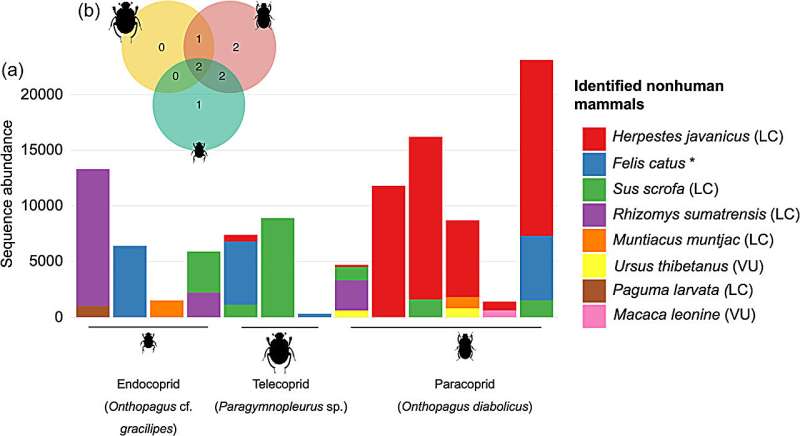This article has been reviewed according to Science X's editorial process and policies. Editors have highlighted the following attributes while ensuring the content's credibility:
fact-checked
trusted source
proofread
Dung beetle iDNA as an additional tool for biodiversity assessment

Many dung beetles use mammalian feces as a food source and build and relocate dung balls to lay eggs and shelter their larvae. This behavior provides many ecosystem services including nutrient cycling, secondary seed dispersal, soil excavation, and parasite and pest control.
Recent studies have shown that the use of genetic information from dung beetle guts (invertebrate-derived DNA, or iDNA) allows for the detection of mammals in a given habitat without intensive survey of the area. However, these studies used live or freshly killed beetles rather than preserved specimens.
In a study published in Integrative Conservation, researchers from the Xishuangbanna Tropical Botanical Garden (XTBG) of the Chinese Academy of Sciences tested whether dung beetles collected using conventional pitfall traps, which preserve specimens with an alcohol-based solution, could be used to extract, sequence, and identify mammalian DNA from their guts.
The researchers extracted iDNA from the guts of 18 dung beetles, comprising three species and three functional groups, collected from a seasonal tropical forest in Xishuangbanna, China. The composition of the detected species differed among the three functional groups, but shared locally common wild boar and domestic cat. Paracoprids preserved the highest number of mammal species (seven out of eight total recorded), including rare species such as the Asian black bear, southern red muntjac, and the northern pig-tailed macaque.
They demonstrated that dung beetle specimens captured by conventional baited pitfall traps can preserve the DNA of mammal species in their guts. Conventional baited pitfall traps can capture different dung beetle species with different mammalian diets over an extended period of time in the field.
"Our technique offers a viable alternative to traditional cafeteria experiments for understanding dung beetle-mammal interactions and can serve as a valuable complementary approach to current mammal survey techniques," said Akihiro Nakamura of XTBG.
More information: Thilina S. Nimalrathna et al, Enhancing the dung beetle iDNA tool for mammalian biodiversity monitoring and ecological studies, Integrative Conservation (2023). DOI: 10.1002/inc3.29
Provided by Chinese Academy of Sciences



















